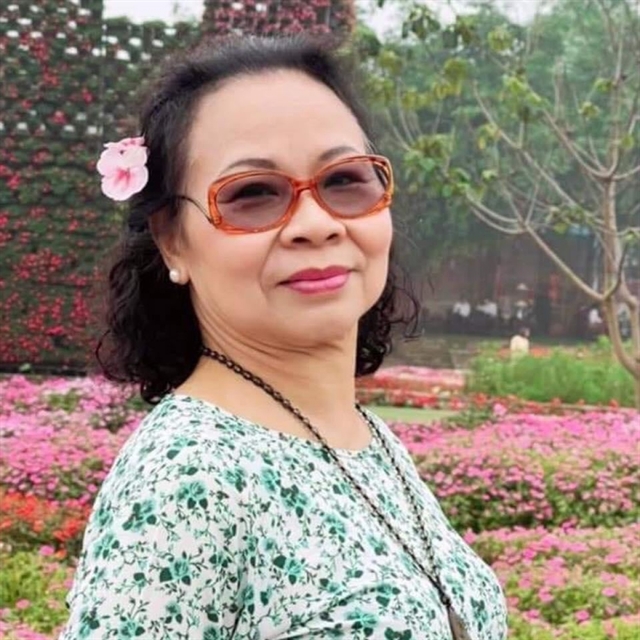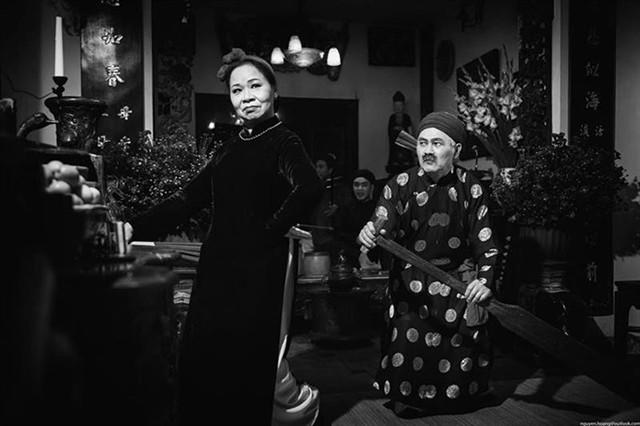
People's Artist Đoàn Thanh Bình. — Photo vov.vn
Artists have to overcome many difficulties to devote themselves to their creative career. Those challenges can be tough for those who seek to keep the fire of passion burning for the nation's traditional arts. Trần Đức Anh spoke with People's Artist Đoàn Thanh Bình about her devotion to the art of chèo (popular opera).
Inner Sanctum: You have been honoured by many as a 'teacher of teachers', but I was told that you have two teachers who influenced you deeply. Can you tell me a little about them?
Oh, the first teacher to mention is my grandmother, People's Artist Trịnh Thị Lan, one of the great artists of Vietnamese chèo. My grandmother taught me to sing chèo when I was 10 years old. Perhaps because I inherited her genes, later, when I decided to take up chèo, I always had a sense of keeping my profession and doing it in a pure and dedicated way. Chèo singing and performance is not only my family's profession but, importantly, one of the treasures of national folk art.
Before my grandmother died, she said in her dying moments that she wanted a grandchild to follow her career. Later, I discovered that she asked People's Artist Trần Bảng to train me.
When I was a child, honestly, I wouldn't say I liked chèo, but I liked cải lương (reformed opera) because both my mother and father are cải lương artists. Living with my parents and listening to and watching cải lương, I fell in love with it. I was determined to become a cải lương artist, and actually, I was an actor in the Bắc Thái Cải Lương Troupe for two years.
However, after my grandmother passed away, I was able to meet Bảng and saw performances by the Việt Nam Chèo Theatre, such as Quan Âm Thị Kính, Lọ Nước Thần (Magical Water Bottle). I was completely conquered by it. I agreed with Bảng, my second teacher, to study chèo at the Việt Nam Intermediate School of Stage Art. After graduating, in 1975, I officially became an artist at the Việt Nam Chèo Theatre.
Inner Sanctum: Can you tell us of any barriers you have had in your career?
In my time, I and probably many artists, have had to deal with two things. First is economic conditions, income, facilities, and equipment for practice and performance. I still remember the 1990s when the theatre's facilities were still lacking. When preparing for a performance, the whole crew had to practise in an abandoned warehouse. In the hot summer weather, actors had to wear three or four layers of clothes depending on the character, and everyone was sweating profusely.
Second is a subjective factor, the personal training of each artist. As I am the paternal grandchild of People's Artist Trịnh Thị Lan, my teachers always set me higher requirements than others.
Inner Sanctum: How did you overcome these barriers?
All things and phenomena exist, and progress comes from each person's subjective perception and evaluation. With the art of chèo, when the artists face difficulties and challenges, it is also the time when they have to explore, practise harder, and overcome barriers of expertise, time, health and even tricky living conditions.
I was often chosen to practise and perform complex songs and plays. Difficult problems motivate me to challenge myself and push myself to become 'higher' and more mature. To become the Đoàn Thanh Bình of today, I don't know how many times I cried.

People's Artist Đoàn Thanh Bình (left) and Meritorious Artist Vũ Ngọc in the play Tuần Ty - Đào Huế. — Photo courtesy of Bình
Inner Sanctum: How do you evaluate the current chèo stage?
It must be said that the chèo stage is challenging right now. In fact, with the development of society, many new art forms have been introduced to our country, leaving most audiences no longer interested in traditional arts.
Besides, innovated chèo scripts suitable for today are very limited. Most scriptwriters have to adapt plays for chèo. However, to successfully adapt a chèo script, they must understand the characteristics and principles of the traditional art. Very few people can do it.
In the past, students had to learn each song or dance by heart and then switch to another song or dance. In their studies, the training time is limited, requiring them to grasp it quickly. The strict training regime but modest remuneration forces many to switch to other professions to earn a living.
Inner Sanctum: What are your hopes, if any, for the future of the chèo stage?
I still have a firm belief in our traditional art of chèo. When I went to Europe for shows, I felt proud because overseas Vietnamese and foreigners also loved chèo and admired this theatrical art.
I hope, in the future, we can train abundant and quality performers for the chèo stage. To do that, the culture authority needs to have a firm policy in educating and publicising this art genre with various measures, such as bringing chèo into schools, increasing training at art schools, and raising the income for artists.
Each chèo artist must also improve their professional ability to keep the fire of chèo in their hearts forever. VNS
OVietnam